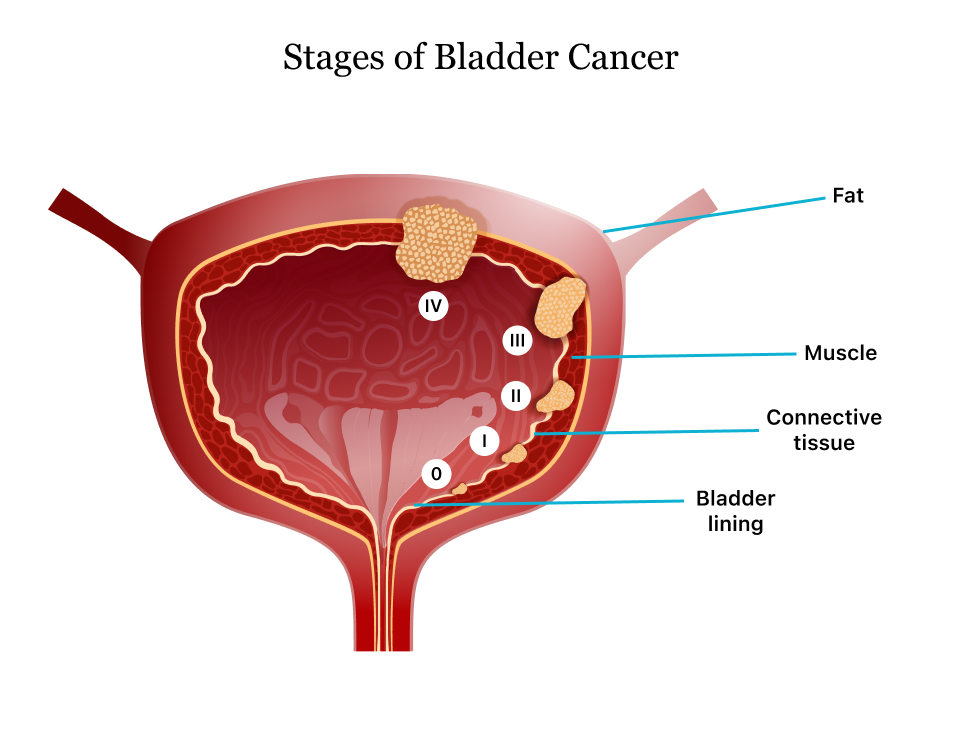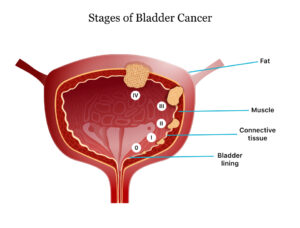Guest Blog: All You Need To Know About Bladder Cancer


What is Urinary Bladder Cancer?
The urinary bladder is a hollow sac-like structure in the pelvis where the body stores urine before it leaves the body.
When cells of the bladder grow abnormally, they can become bladder cancer. A person with bladder cancer will have one or more tumors in his/her bladder.
What are the symptoms of Bladder Cancer?
Blood in the urine is the most common symptom of bladder cancer. It is generally painless. Frequent urination, urgency, and pain when you pass urine (dysuria) are less common symptoms of bladder cancer. If you have these symptoms, it’s important to see a urologist.
What Causes Bladder Cancer?
You are more likely to get bladder cancer if you smoke or breathe in tobacco smoke. Smoking tobacco is the cause of nearly 50% of bladder cancers. Longstanding exposure to chemicals used to make plastics, paints, textiles, leather, and rubber also leads to bladder cancer.
How is bladder cancer diagnosed?
Physical examination is usually normal in early bladder cancer. Your urologist will ask you to get a complete urine examination, Ultrasound of abdomen and pelvis, computerized tomography scan ( CT scan) of abdomen & pelvis, and urine for malignant cytology. Urine examination may show blood cells. Urine for malignant cytology will show the cancer cells shredded in urine. It is usually positive in high-grade tumors. On Ultrasound and CT scans, bladder cancer is diagnosed as discrete single or multiple growths into the bladder lumen. CT scan can also stage bladder cancer depending on the extent of spread outside the bladder.
What is the treatment for bladder cancer?
Treatment of bladder cancer depends on the grade and stage of cancer. High grade and high stage tumors are biologically different from low grade and low stage tumors. They are aggressive with a high risk of recurrence and progression.
For prognosis and treatment purposes, Bladder cancer is divided into two groups- Non-muscle invasive bladder cancer ( NMIBC) and Muscle invasive bladder cancer(MIBC).
The various treatment options for bladder cancer are-
Cystoscopy and TURBT
Intravesical therapy
Radical cystectomy and urinary diversion
Radiotherapy
Multimodality therapy
Initial treatment of bladder tumors involves cystoscopy and Transurethral resection(TURBT). In this procedure, the tumor is cut into small pieces with an endoscope passed through the urine passage into the bladder. The excised tumor tissue is sent for biopsy.
The further treatment of bladder cancer depends on the biopsy report.
1. Cancers which are not involving the muscle layer of the bladder on biopsy are called Non-muscle invasive bladder cancers (NIMBC). 70% of bladder cancers on diagnosis are NMIBC. TURBT is the only treatment necessary for small superficial low-grade papillary bladder cancers. Tumors involving the submucosal layer require adjuvant intravesical therapy following TURBT.
Intravesical therapy is given 4 wks after the TURBT procedure. BCG vaccine used for immunization against Tuberculosis is found to have a protective effect against bladder cancer. BCG is the most used intravesical therapy for bladder cancer. It is known to reduce the recurrence and delay the progression of bladder cancer.
For those who cannot tolerate BCG therapy, intravesical chemotherapy is given. The drugs commonly used are Mitomycin and Gemcitabine. Intravesical therapy is usually given as weekly installation for 6 wks later 3 weekly instillations at 3–6-month intervals for 1-3 years.
After TURBT and intravesical therapy, one must be on the regular follow-up to check for recurrences. Follow-up is done by check cystoscopy, urine cytology. Low-grade papillary tumors need a follow-up for one year, whereas high-grade tumors need follow-up for a lifetime.
2. Cancers that involve the deep muscle layer of the bladder wall on TURBT biopsy are labeled as Muscle invasive bladder cancers (MIBC). The treatment of MIBC is radical cystectomy (removal of the bladder) with urinary diversion or radiotherapy.
Certain advanced bladder cancers are treated with upfront chemotherapy to downsize the tumors before radical cystectomy surgery.
Radical cystectomy with urinary diversion is a major operation, can be performed by open laparoscopic or robotic method. An ileal conduit is a simpler type of urinary diversion. In this procedure, following cystectomy, both the ureters(urine tubes carrying urine from kidneys to bladder) are attached to a small isolated segment of the small intestine which is brought out as a stoma on the abdominal wall. The patient has to wear an appliance to the abdominal wall to collect urine.
In another type of urinary diversion called Orthotopic neobladder, a new bladder is constructed with intestine and connected to normal urinary passage. In neobladder diversion, the patient passes urine normally through the urethra.
About the author- Dr. Suryaprakash V, Urologist, Yashoda Hospital, Somajigudda, Hyderabad
